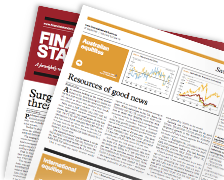Fixed income outlook for 2025BY CHAMATH DE SILVA | VOLUME 19, ISSUE 1It is fair to say that 2024 came to be defined by the final few months, where the US political election, growing fiscal risks, and an ever-resilient US economy sent benchmark ... Get articles like this delivered to your email - Sign up for the free weekly newsletter More Articles |
Latest News
Former financial adviser charged in alleged $160k super fraud case
|Former financial adviser Abdullah Popal has been charged with alleged fraud offences in Sydney's north-west, accused of hoodwinking five individuals out of over $160,000 from their self-managed super funds (SMSFs).
Reducing super tax cap to $2m 'a concern': FAAA
|The FAAA has voiced concerns over the Labor government's proposed superannuation tax, saying if they are negotiating with the Greens, a reduction in the cap to $2 million would be problematic.
FAAA calls for stronger consumer protections in advice reforms
The Financial Advice Association of Australia (FAAA) has opposed collective charging for "always complex and costly" retirement planning advice and emphasised the need for consumer protection in the provision of super nudges in its submission to Treasury on the Delivering Better Financial Outcomes (DBFO) ...
Adviser numbers jump in March quarter: Rainmaker
The March quarter saw the highest number of financial advisers join the sector in the last seven years to reach 15,982, according to Rainmaker Information.
Further Reading
Cover Story

Moving mountains
MAGDELINE JACOVIDES
FOUNDER AND FINANCIAL ADVISER
MAZI WEALTH
FOUNDER AND FINANCIAL ADVISER
MAZI WEALTH
On top of running a successful practice, Mazi Wealth founder Deline Jacovides is a fierce advocate for closing the superannuation gender gap and has built a highly popular social media presence that takes financial literacy to the next level. She tells Karren Vergara where her passion comes from and how she integrates it all with family life.

























